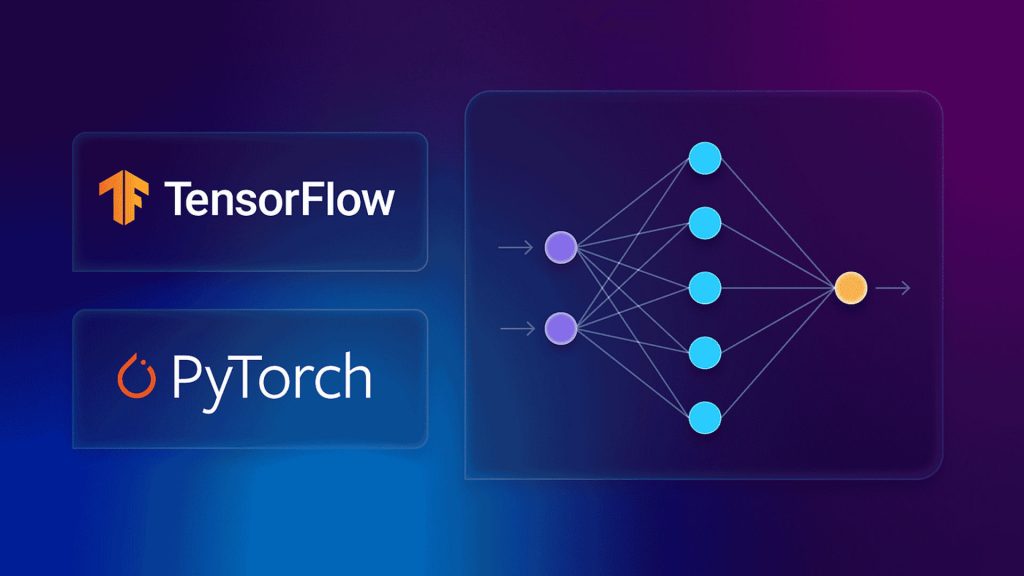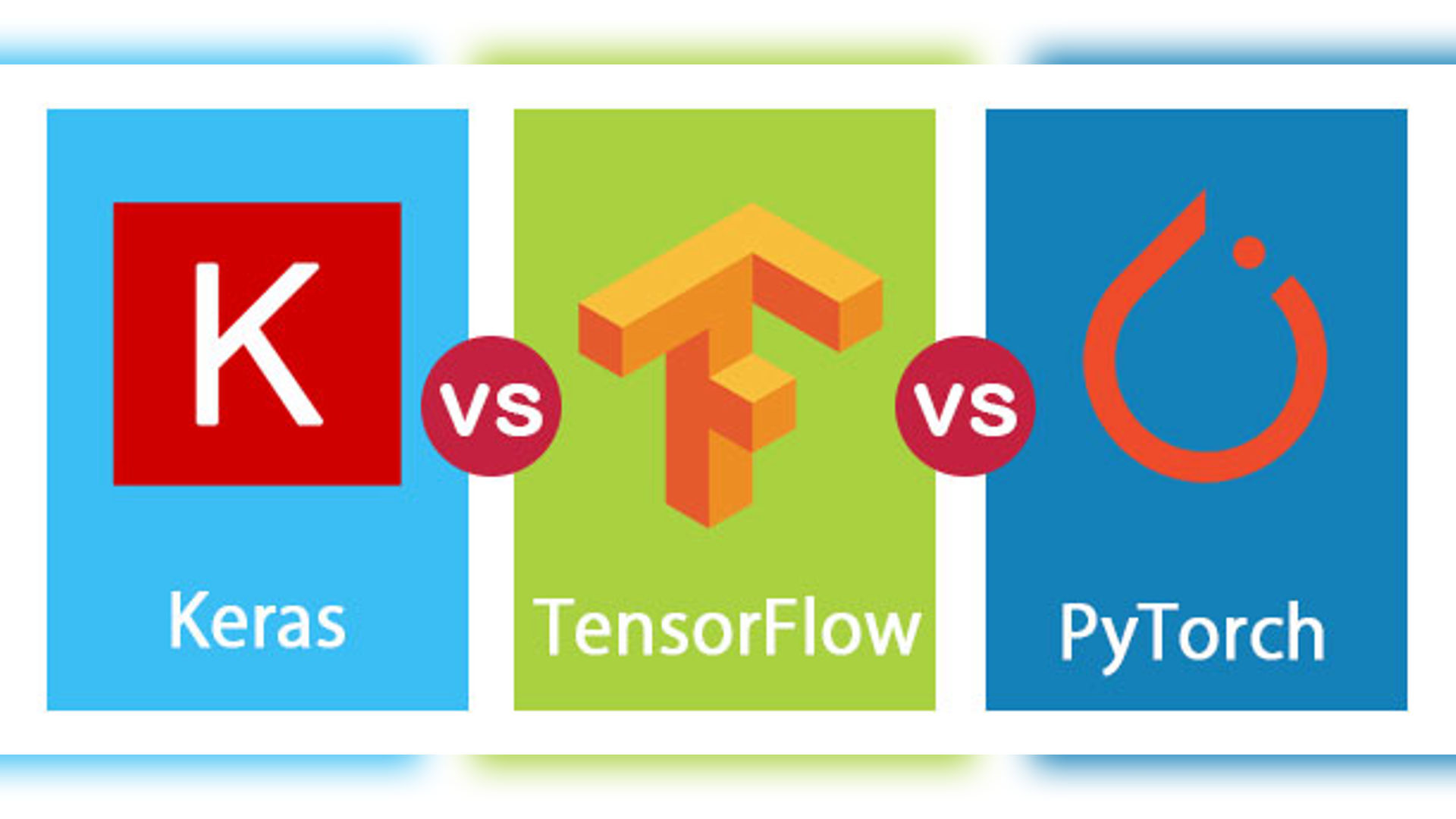Artificial Intelligence (AI) has revolutionised technology, and developers rely on powerful frameworks to build AI models. Among the most popular are TensorFlow, PyTorch, and Keras—each offering unique features suited for different applications. In this comprehensive guide, we will compare these three frameworks, highlighting their differences, strengths, and best applications to help you choose the right one for your AI projects.
Understanding TensorFlow, PyTorch, and Keras: Key Features and Benefits
Before diving into the differences between TensorFlow, PyTorch, and Keras, it’s important to understand what makes each AI frameworks unique and how it can benefit your AI projects.
TensorFlow
Developed by Google, TensorFlow is an open-source deep learning framework that provides a range of flexible tools and libraries for building AI models. It supports both high-level (via Keras) and low-level APIs for model development, making it ideal for large-scale enterprise applications.
Learn more about TensorFlow
PyTorch
Created by Meta (Facebook), PyTorch is known for its dynamic computation graphs, which make it an excellent choice for research and academic communities. PyTorch is also gaining traction in production-level AI applications due to its flexibility and ease of experimentation.
Learn more about PyTorch
Keras
Keras is a high-level API that simplifies the process of building deep learning models. Originally independent, Keras is now integrated into TensorFlow as tf.keras. It’s particularly well-suited for beginners and developers who need fast prototyping for AI applications.
Learn more about Keras
Why Choosing the Right AI Framework Matters
Choosing the right framework is crucial to building efficient AI Frameworks. Here’s why TensorFlow, PyTorch, and Keras are widely used in the AI community:
- Scalability & Flexibility: TensorFlow and PyTorch both support large-scale AI models, making them suitable for complex projects.
Explore TensorFlow’s scalability - Ease of Use: Keras is a user-friendly framework that simplifies model building with its straightforward API.
Get started with Keras - Performance Optimisation: TensorFlow and PyTorch leverage GPUs for faster processing and better performance.
Optimise TensorFlow performance - Dynamic vs. Static Computation Graphs: PyTorch’s dynamic computation graphs contrast with TensorFlow’s static graphs, each with its own set of advantages.
Explore TensorFlow static graphs - Interoperability: All three frameworks work well with popular tools such as NumPy and OpenCV.
TensorFlow interoperability - Strong Community Support: Each framework has a robust developer and researcher community contributing to its growth.
TensorFlow community, PyTorch community - Industry Adoption: Many leading companies, including Google, Facebook, and Tesla, use these frameworks for AI research and applications.
TensorFlow industry use cases, PyTorch use cases
1. Scalability & Flexibility: Which Framework is Right for You?
TensorFlow
TensorFlow is a great choice for large-scale AI applications and enterprise-level solutions. With support for both high-level and low-level APIs, it provides developers with the flexibility they need for complex projects. TensorFlow is designed to work across multiple platforms (mobile, web, cloud), making it ideal for distributed computing.
PyTorch
PyTorch is highly flexible, especially for research and prototyping. Its dynamic computation graphs allow for real-time model updates, and its support for TorchScript enables deployment in production environments.
Learn more about deploying with TorchScript
Keras
While Keras is ideal for rapid development and prototyping, it is less flexible than TensorFlow and PyTorch when it comes to low-level modifications. It’s best suited for small to mid-scale AI projects that require a quick turnaround.
Getting started with Keras
2. Ease of Use: Simplifying Model Development
TensorFlow
TensorFlow offers both low-level (manual control) and high-level APIs (Keras). While the learning curve can be steep due to static computation graphs and configurations, TensorFlow’s well-documented resources make it easier to grasp.
Understanding TensorFlow APIs
PyTorch
PyTorch is known for its simple, Pythonic interface, making it highly intuitive. The dynamic computation graphs of PyTorch also simplify debugging, making it a great choice for researchers and developers focused on experimentation.
PyTorch documentation
Keras
Keras is the easiest framework to use, with minimal coding required to build models. Its simplicity and clear API make it the top choice for beginners and those focused on fast prototyping.
Learn Keras
3. Performance Optimisation: Speed and Efficiency
TensorFlow
TensorFlow supports GPU and TPU acceleration, making it highly optimised for performance. The static computation graphs improve processing efficiency, and TensorFlow’s distributed training capabilities allow models to scale across multiple GPUs and cloud environments.
TensorFlow GPU acceleration
PyTorch
PyTorch also excels in performance, with strong GPU support using CUDA. While dynamic computation graphs introduce slight overhead, PyTorch’s flexibility in deployment makes it an excellent choice for many AI applications.
PyTorch CUDA support
Keras
Keras benefits from TensorFlow’s optimisations, leveraging GPU support and cloud computing capabilities. However, it may not be as suitable for complex deployments compared to TensorFlow and PyTorch.
Optimising Keras performance
4. Dynamic vs. Static Computation Graphs: A Key Differentiator
TensorFlow
TensorFlow uses static computation graphs, which are optimised for production but can be more challenging to debug and modify in real-time.
Learn more about TensorFlow graphs
PyTorch
PyTorch’s dynamic computation graphs are built on the fly, offering flexibility and ease of debugging, making it particularly favoured for research and rapid experimentation.
Keras
Keras abstracts away graph complexities, simplifying model development by relying on TensorFlow’s backend. It’s great for high-level model building but not suitable for those seeking low-level control.
5. Interoperability: Seamless Integration with Other Tools
TensorFlow
TensorFlow integrates seamlessly with popular tools like NumPy, OpenCV, and ONNX. It also supports web (TensorFlow.js) and mobile (TensorFlow Lite) applications, making it versatile for various AI use cases.
TensorFlow Lite
PyTorch
Like TensorFlow, PyTorch works well with tools like NumPy, OpenCV, and ONNX. Its integration with TorchScript allows it to be deployed in C++ environments.
Deploying with TorchScript
Keras
Keras inherits many of TensorFlow’s interoperability features, but its flexibility is limited compared to TensorFlow and PyTorch. It’s best suited for TensorFlow-based models.
Learn how Keras integrates with TensorFlow
6. Community & Support: The Power of Collaboration
TensorFlow
With strong backing from Google, TensorFlow has an extensive community and frequent updates. Its documentation and resources are top-notch, making it easy to get started and stay supported.
TensorFlow Docs
PyTorch
PyTorch is developed by Meta (Facebook) and has grown in popularity in academia and research communities. It’s now gaining traction in production environments as well.
PyTorch community
Keras
Keras, now part of TensorFlow, benefits from the support of TensorFlow’s robust community, making it an excellent choice for learning and early-stage AI projects.
Keras support
7. Industry Adoption: Who Uses These Frameworks?
TensorFlow
TensorFlow is widely adopted by tech giants like Google, Tesla, and Airbnb for large-scale AI applications. Its extensive industry use makes it the preferred choice for enterprise solutions.
TensorFlow in industry
PyTorch
PyTorch has seen rapid adoption in research and academia, with companies like Microsoft and Tesla using it for production-level AI.
PyTorch in research
Keras
Keras is primarily used for prototyping and small projects. While it’s excellent for rapid development, it’s less common in large-scale deployments compared to TensorFlow and PyTorch.
Learn how Keras is used
Choosing the Right Framework for Your AI Projects

When it comes to building AI models, the choice of framework matters. Here’s a quick guide:
- TensorFlow is the best option for large-scale, production-ready AI projects.
- PyTorch shines in research and flexible development.
- Keras is perfect for beginners and rapid prototyping.
Regardless of which framework you choose, all three continue to evolve and provide powerful tools for building cutting-edge AI models. Start building your AI models today and leverage these frameworks to bring your ideas to life!
FAQ
Question: What is TensorFlow?
Answer: TensorFlow is an open-source deep learning framework developed by Google, offering both high-level (via Keras) and low-level APIs for building AI models. It’s ideal for large-scale enterprise applications and supports deployment across various platforms, including mobile and cloud environments.
Question: What is PyTorch?
Answer: PyTorch is an open-source deep learning framework developed by Meta (Facebook). It is known for its dynamic computation graphs, making it a popular choice for research and academic communities. PyTorch also supports deployment in production-level AI applications, offering flexibility and ease of experimentation.
Question: What is Keras?
Answer: Keras is a high-level API for building deep learning models. Originally independent, it is now integrated into TensorFlow as tf.keras. Keras simplifies the process of model building with its user-friendly interface, making it particularly well-suited for beginners and developers needing fast prototyping for AI applications.
Question: How do TensorFlow, PyTorch, and Keras differ in terms of computation graphs?
Answer: TensorFlow uses static computation graphs, which can lead to more optimized performance but may be less flexible. PyTorch employs dynamic computation graphs, allowing for real-time model updates and greater flexibility during development. Keras, being a high-level API, abstracts away the details of computation graphs, focusing on ease of use.
Question: Which framework is best for large-scale AI applications?
Answer: TensorFlow is well-suited for large-scale AI applications due to its scalability, support for distributed computing, and deployment capabilities across various platforms.
Question: Which framework is preferred for research and prototyping?
Answer: PyTorch is favored in research and prototyping due to its dynamic computation graphs, which facilitate real-time model updates and experimentation.
Question: Which framework is best for rapid development and prototyping?
Answer: Keras is ideal for rapid development and prototyping because of its simple, high-level API that allows developers to quickly build and test models.
Question: How do these frameworks support GPU acceleration?
Answer: All three frameworks: TensorFlow, PyTorch, and Keras, support GPU acceleration, enabling faster processing and better performance for training deep learning models.
Question: What are the community and industry adoption aspects of these frameworks?
Answer: Each framework has strong community support and industry adoption. TensorFlow is widely used in production environments, PyTorch is popular in academic research, and Keras is often used for quick prototyping and educational purposes.
